The mystery of a giant 1.5-meter-long worm eating both hydrogen sulfide and rotten gas
- Top 11 exotic animals you may have heard for the first time
- 15 moments of coincidence coincidence to surprise
- Eels longer than 2m tore apart the "cousins" mercilessly
Scientists finally understand why this nearly 1.5-meter-long giant worm can eat both hydrogen sulfide and rotten gas. Invite you to consult!
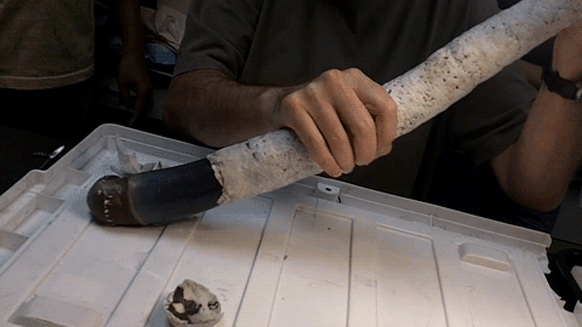
The image above is scary at many levels, depending on the work you are doing, may be considered unsafe. What you are seeing is a large species of shipworm , a scientific myth that can be up to 1.5 meters long. In fact, the shipworm is a super-long mollusk, which grows vertically in a thick crust under the mud layer of rivers and lakes with two suction taps protruding to either side. Basically, according to biologists, this animal is very bizarre.
Biologists have known about this worm and what material makes its shell, but have not found a living specimen to study. The mystery kept going on until 2010, when a scientist watched the Philippine TV channel about two divers looking for the worm before they could find its shelter.
The location of this worm will be kept secret, because their precious shells cost up to $ 200 / piece. Therefore, scientists need to protect this " less lovely " animal in the eyes of ambitious farmers. That information is kept secret by the biologist Daniel Distel in the scientific report published in the Minutes of the National Academy of Sciences.
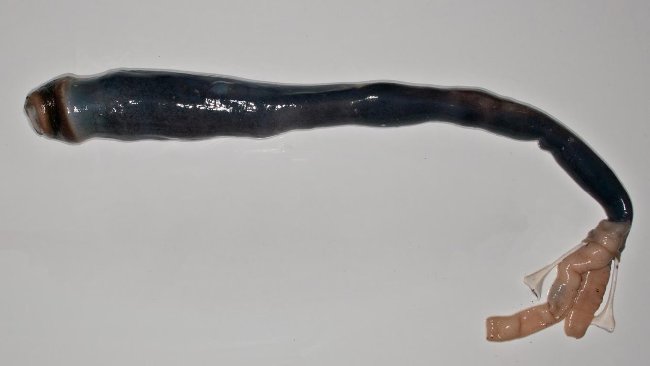
You may have heard of the shipworm before . In fact, this boat worm is nothing more than a destructive animal: they pierce the hull and damage the dock . In the past, it was thought that this worms could only be 60cm smaller than their brothers. So why is the new specimen so big? This long-standing mystery may be answered when scientists acquire a living specimen.
Before touching this specimen named Kuphus polythalamia , biologist Distel suggested that the worms often saw a puncture of wood, but could not digest the wood itself. So their bearing contains a special bacterium that produces enzymes to transfer to the stomach to digest cellulose into sugar.
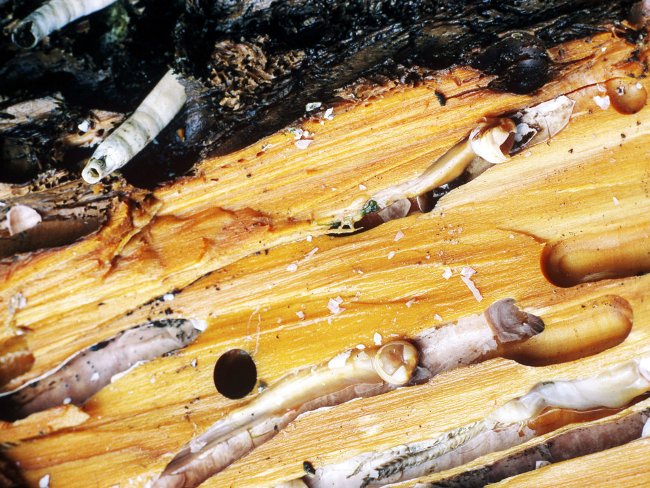
According to biologist Distel, in some way, this worm can live on logs in shallow water in the Philippines. They can live as earthworms, crawl in the soil, eat humus and filter out organic matter. " It seems reasonable, but when we see the end of the tube that the worms live without any holes, the idea of 'living like earthworms' cannot exist ," Distel said.
So which way will this worm take waste out when the end of the pipe has no escape route? Perhaps this worms eat in a filtered manner from the outside? Or maybe this big worm uses a nozzle to pick up plankton in the water. " We do not think that zooplankton are the main source of nutrition for this worm, because their whole bodies are covered with large filter and their digestive organs are very minimal ," said Margo Haygood microbiologist. , co-author said.
Large gills are one of the main research factors. It is possible that this large worm works like pipe worms living in large hydrothermal vents, using special bacteria to digest hydrogen sulfide poison gas - which is found both in the seabed and rotting mud pools at the bottom of the Philippines.
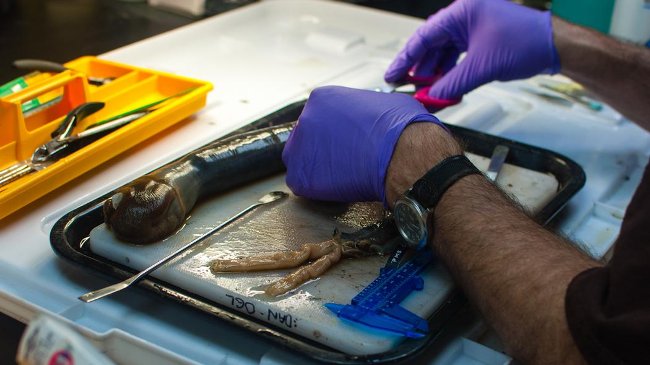
When Professor Distel dissected the first living specimen, he discovered that the bacteria that existed in these large gills were exactly the same as regular pipe worms. But when they deepened their research into their genome, they discovered the genes of other bacteria used to digest, treat hydrogen sulfide rotten gas. So biologists can give the first conjecture that these boat worms " eat " hydrogen sulfide rotten gas, and then synthesize symbiotic bacteria into their energy.
That is why the bearing of this worms is so big and the digestive system is so small - because their gills also have a place to store bacteria and do not need a digestive system. " It is a kind of convergence of evolutionary elements. It is very similar to the way the worms live in the ocean. Most of the body's compartments are occupied by this organ that is full of species. symbiotic organisms These boat worms grow big because in that habitat - under the ocean floor - always flooded with hydrogen sulfide, a food that no other creature competes with for their food there are some species that eat hydrogen sulfide rotten gas , "Ms. Haygood said.
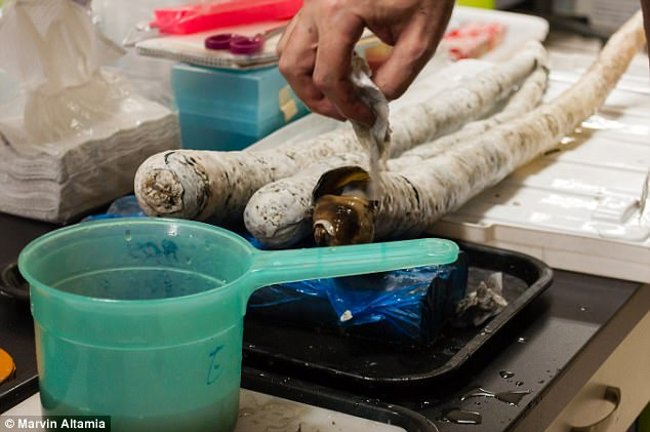
So how do these big boat worms differ from their wood-eating brothers? Perhaps the difference is similar to the way that the giant sea-dwelling mussel can live in hydrothermal circuits. In 2000, Professor Distel discovered a tiny mussel - no bigger than sesame seeds - living on the hydrogen sulfide rotten gas from woody items that also grew bigger thanks to a symbiotic bacterium. It may have been a long time since the mussels had sunk to the bottom, found hydrogen sulfide veins, lived on it and grew up with abundant food.
Maybe this species of worms also evolved with the same way. " If the ancient shipworm species developed and acquired additional sulfur-oxide-symbiotic organisms, they would have found a habitat that contained both wood and hydrogen sulfide. , these symbionts become the evolutionary stepping stone for boat worms, allowing them to turn from wood-eating into hydrogen sulfide-eating species , "Professor Distel said.
Everything suddenly became clear. The other boat worms, although they look " ugly ", at least help us understand a little more about it. This article helps you understand more about the species - the unique worms.
Having fun!
You should read it
- Strange worms grow 2 heads when living for 5 weeks in the universe
- Not the fireflies, the new carnivores are the glowing ones in this cave
- Two new earthworms are found in Kerala
- Pests can eat plastic, savior of man-made plastic waste
- The strange creature re-grows its head, turning its prey into water
- The bizarre blue creature has super long pink tongue
- Goose bumps with movements like fictional creatures of bloodworms
- Trojan worms' hybrid
May be interested
- 5 absolute things should not be done after eating
 so what to do after a meal? within at least 30 minutes after eating, you absolutely should not do 5 things below to protect your health!
so what to do after a meal? within at least 30 minutes after eating, you absolutely should not do 5 things below to protect your health! - The Pacific and 5 unexplained mysteries challenge scientists
 the pacific ocean is the largest ocean on earth with an area of 161,800,000 km2. this vast and quiet sea contains a lot of mysteries that make scientists crazy to decode but so far there is no solution like sudden civilizations disappearing, mysterious airplane disappearances. , giant monsters ...
the pacific ocean is the largest ocean on earth with an area of 161,800,000 km2. this vast and quiet sea contains a lot of mysteries that make scientists crazy to decode but so far there is no solution like sudden civilizations disappearing, mysterious airplane disappearances. , giant monsters ... - The effects of walking after eating that you may not know
 here are some of the top reasons why walking after meals can be a simple yet effective habit to add to your daily routine, according to health experts.
here are some of the top reasons why walking after meals can be a simple yet effective habit to add to your daily routine, according to health experts. - The mystery of the 290-million-year-old giants challenges scientists around the world
 according to the study, this fossil footprint dates back to the permian period (from 248 to 290 million years ago), far away from the time when humans and birds appeared on earth.
according to the study, this fossil footprint dates back to the permian period (from 248 to 290 million years ago), far away from the time when humans and birds appeared on earth. - Floating equipment can obtain hydrogen gas from seawater
 hydrogen is a clean fuel, but current production methods, usually by converting natural gas, can be harmful to the environment.
hydrogen is a clean fuel, but current production methods, usually by converting natural gas, can be harmful to the environment. - The 15-year-old girl lost her life because of her hair-eating syndrome
 according to some doctors in the uk, a teenage girl has died after eating her own hair for a long time.
according to some doctors in the uk, a teenage girl has died after eating her own hair for a long time. - D32 Virus Removal Software updates new viruses on December 25, 2004
 d32 software (december 25, 2004) updates the viruses dob2k.worm.w32, dotnet.worm.w32, ebscam.htm.trj.w32, elizabeth.worm.w32, hydra.exe.worm.w32, hydra. gen.worm.w32, invalidssl.worm.w32, netsky.ag.exe.worm.w32, netsky.ag.gen.worm.w32, outa2k.worm.w32 and zombie.gen.worm.w32.
d32 software (december 25, 2004) updates the viruses dob2k.worm.w32, dotnet.worm.w32, ebscam.htm.trj.w32, elizabeth.worm.w32, hydra.exe.worm.w32, hydra. gen.worm.w32, invalidssl.worm.w32, netsky.ag.exe.worm.w32, netsky.ag.gen.worm.w32, outa2k.worm.w32 and zombie.gen.worm.w32. - Giant 8 kg mushroom found in China
 a giant 8-kilogram and 1.8-meter giant mushroom was found in yunnan province in southwest china.
a giant 8-kilogram and 1.8-meter giant mushroom was found in yunnan province in southwest china. - The method of making clean and cheap hydrogen fuel from methane
 researchers have developed an electron-separating reactor that is electrically operated and allows the production of tropical hydrogen with almost zero loss of energy.
researchers have developed an electron-separating reactor that is electrically operated and allows the production of tropical hydrogen with almost zero loss of energy. - What is hydrogen water purifier? Is hydrogen water purifier good?
 let's find out what is hydrogen water purifier and hydrogen water purifier is good for you!
let's find out what is hydrogen water purifier and hydrogen water purifier is good for you!










 The inexplicable mystery of the legendary 'ghost island' lies in the middle of the Atlantic Ocean
The inexplicable mystery of the legendary 'ghost island' lies in the middle of the Atlantic Ocean Startled with houses built on unbelievable terrain
Startled with houses built on unbelievable terrain 7 cases of 'cross-space' mystery makes science 'bundle'
7 cases of 'cross-space' mystery makes science 'bundle' Despite the usual laws of physics, these 10 surreal locations are causing headaches for scientists
Despite the usual laws of physics, these 10 surreal locations are causing headaches for scientists The mysterious 'ghost ship' was discovered on Lake Superior
The mysterious 'ghost ship' was discovered on Lake Superior 8 mysterious natural phenomena that make scientists 'crazy'
8 mysterious natural phenomena that make scientists 'crazy'